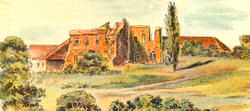Tutschin Parish History
The Parish of Tutschin (Tuczyn) (1888)
Again due to population growth in and around Rowno, partly due to the completion of the railroad through Volhynia, congregations in the County of Rowno and nearby areas were separated from the Parish of Zhitomir in 1888 and formed a new "Permanent Adjunct" or parish centered in the centrally-located small town of Tutschin. Thus began the "second round" of parish-formation, which would continue with communities around Nowograd Wolynsk being separated from Zhitomir Parish in 1889 and the Parish of Wladimir Wolynsk being formed in 1891 out of Roshischtsche Parish. (Technically, these were "Permanent Adjuncts" of Zhitomir and Roschischtsche, not parishes, since the Tsarist government's mistrust of Volhynian Germans in these years militated against the formation of true parishes. The Parishes of Luzk, Emiltschin, Radomysl and Rowno were also technically "Adjuncts". In actuality, however, they all functioned as parishes, and are normally called by this name.)
Tutschin Parish had 56 chapel/schools at the start and either about 4000 parishioners (1909 source) or over 25,000 (Kneifel)! It had no churches. The pastor rented a place to live in Tutschin until a manse was built in 1897. By 1902 it was felt necessary to separate from the Tutschin parish several communities in the counties of Ostrog, Kremenez (Krzemieniec), Dubno and Luzk. These became the Parish of Rowno. According to Kneifel, Tutschin Parish counted 12,739 parishioners in 1904 and about 17,000 in 1914, in 44 cantorates.
This growth occurred in spite of the fact that Tutschin Parish suffered particularly from emigration after 1906, when the Peasant Land Bank took possession of many properties that German colonists had been leasing. To make these lands available for purchase by Russian peasants, the colonists were forced to leave when their lease ran out. Siberia, the Baltic Provinces, Germany and America were their destinations. No fewer than seven German colonies in this parish were decimated in this way. Pastor Oskar Schneider tried vainly to erect a church in Tutschin, but the parish showed little interest. Only a foundation was built.
Following the exile of 1915-1918, the parish stood largely in ruins. Six thousand returnees now farmed about one-third of the land farmed in 1914. The "danger of sects" (Kneifel's phrase) was great. Adventists, Sabbatists and "Footwashers" operated freely until 1923, when Pastor Krusche arrived on the scene and opposed them with vigor. He also saw that Kostopol was becoming a center of Evangelical activity and built a church there. A new church was also built in Toptscha in 1927, in time to be the center of the town's 50th anniversary celebrations in 1930. The year 1930 also saw the dedication of a new church in Horodyszcze and a new chapel in Kartschemka (Karczemka). A small church and school were built in Kamenka in 1934, while Amelin received a new chapel and school in 1933 and Puchawa a chapel in 1935. Kneifel singles out Karl Fibich as a particularly significant cantor and teacher from 1888 to 1931.
Pastors in Tutschin Parish
| 1888 – 1902 | Ernst ALTHAUSEN |
| 1902 – 1912 | Oskar SCHNEIDER |
| 1913 – 1915 | Karl MÜLLER |
| 1918 – 1921 | Erhard TORINUS |
| 1921 – 1924 | Georg RUSNOK |
| 1924 – 1931 | Ernst Waldemar KRUSCHE |
| 1931 – 1936 | Jakob FUHR |
| 1936 – 1940 | Hugo Karl SCHMIDT |
Evangelical Congregations in Tutschin Parish
| Alt-Kurgan+ | Kamenka (Kamionka)+~ | Neu-Kurgan+ |
| Amelin (Amelyn)+ | Karlinuwka+ | Niespodsjanka I+, II+, and III+ |
| Antonieff (Antoniow)+ | Kartschemka+~ | Pemkow+ |
| Antonowka (near Berezno)+ | Kolowert I+ and II+ | Pjaskow+ |
| Berestowez (Berestowiec)+ | Kostopol+ | Puchawa+~ |
| Boruwka+ | Krucha+ | Rudinka+ |
| Chotinka (Chotenka, Neudorf)+ | Kuplja+ | Salomka (Solomka, Friedrichsdorf)+ |
| Dolganez+ | Kurgany+ | Schaljanka+ |
| Dombrowa+ | Kutu-Salesje+ | Shelesniza (Zeleznica, Zeleznitz)+ |
| Friedrichsdorf (Solomka) | Ljubomirka | Toptscha (Topcza)+ |
| Horodischtsche+ | Marcelinhof (Muschtscha)+ | Trigubiza+ |
| Januwka (Janowka)+ | Maximilianuwka+ | Tutschin (Tuczyn)+ |
| Jutschin+ | Mitzk+~ | Welikoje Pole+ |
| Kamenka (near Mizk)+ | Muschtscha (Maszcza, Marcelinhof)+ | Zeleznica (Shelesniza)+ |
+ village with a school which was usually also used as a chapel (Betsaal)
~ village with a separate chapel (Kapelle or more commonly, Betshaus)
* villages where land was owned by the farmer (in contrast to those where it was leased from a nobleman)
Sources:
1. PINGOUD, G.: "Die evangelisch-lutherischen Gemeinden in Rußland", herausgegeben von der Unterstützungs-Kasse für Evangelisch-Lutherische Gemeinden in Rußland; Band 1: "Der St. Petersburgische und der Moskowische Konsistorialbezirk", St. Petersburg, 1909
2. KNEIFEL, Eduard: "Die evangelisch-augsburgischen Gemeinden in Polen 1555 - 1939", Selbstverlag des Verfassers, Vierkirchen 1971


